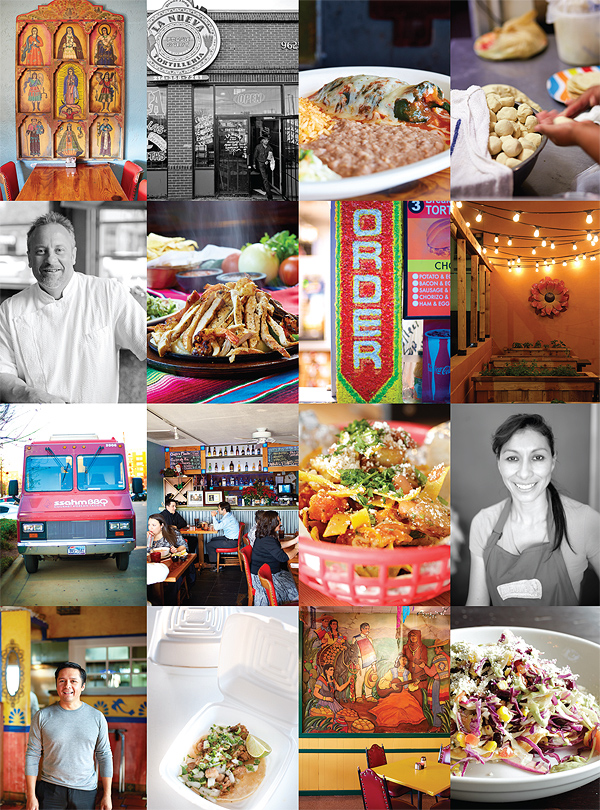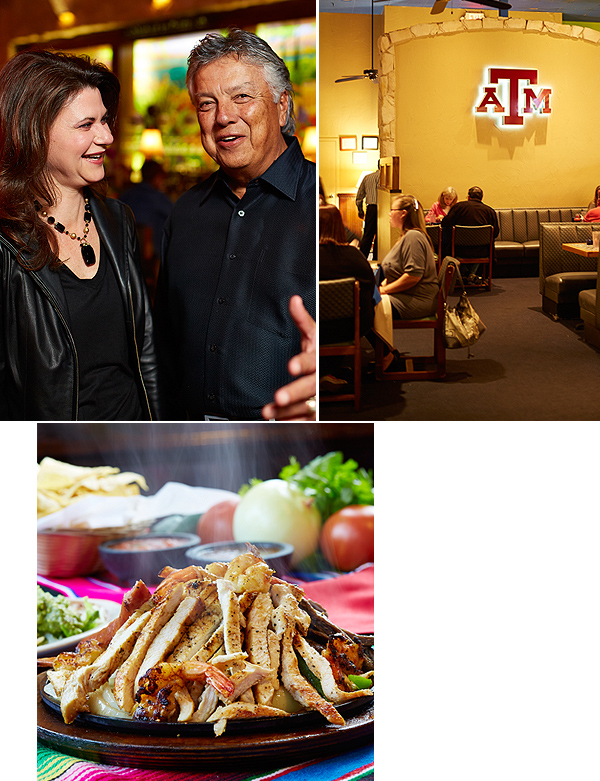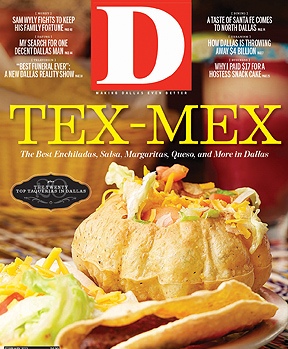Let’s begin with two words: processed cheese.
In this age of artisanal, responsibly raised protein, people shudder when they read those words. But you can’t have Tex-Mex—still the most meaningful cuisine to emerge from this state—without it.
We’re all about understanding other cultures and learning to appreciate Mexico’s authentic regional cuisines. Love that stuff wrapped in the banana leaves. Love the million and one moles. But those are, well, Mexican cuisines. Tex-Mex is ours. Its gold standard is the cheese enchilada, and a cheese enchilada requires greasy, yellow cheese. So does a soft cheese taco. So does a platter of nachos. And, of course, chile con queso is nothing but. We’re talking American. We’re talking Velveeta.
Newcomers eager to try Dallas’ most famous cuisine tend to be, if not dismayed, then certainly unsettled the first time a server shoves a platter—“Hot plate!”—of earth-tone glop in front of them. Maybe you had to grow up with it. For sure you have to live with it awhile to love it. But for most of us, Tex-Mex is the taste we crave when we are away and the one that defines “home.” Most of us have a steady relationship with our favorite Tex-Mex place, our go-to joint that makes it just the way we like it. No matter that there’s only one way to make a real cheese enchilada (soften a tortilla in hot, flavored fat, roll it around chopped onions and grated cheese, cover it with thinned chili con carne and more grated cheese). Each restaurant has its own signature flavor. You can argue the superiority of your favorite until you’re azule in the face, but it’s like trying to convince a Philadelphian that Pat’s is better than Geno’s. Or vice versa.

El Chico. El Fenix. Ojeda’s. Herrera’s. Spanish Village. Casa Dominguez. The yesteryear giants of Tex-Mex restaurants each started out as a mom-and-pop business, one Mexican immigrant family’s toehold on a new life in the United States. Mom and pop can’t be everywhere at once, so they worked one location. Because early Tex-Mex was a low-budget business, it made sense to use cheap ingredients that would keep a long time, incorporate a minimum of meat, and find the flavor with a blast of ground chili and cumin.
Dallasites used to have an inferiority complex about the quality of their Tex-Mex. Most Texans considered the best to be made in Austin and San Antonio. (That’s why Pete Dominguez billed his local Tex-Mex as “Austin style.”) No mas. Dallas can be proud of its rich variety of Tex-Mex restaurants, which range from serious barrio to white-bread style.
For this story, we went looking for the best of the mom-and-pops. We considered only those with one location (which meant omitting a number of favorites). After eating at nearly 20 restaurants, we picked nine. There is one glaring omission: Mia’s Tex-Mex Restaurant. On the day we ate at the Lemmon Avenue restaurant that Butch and Ana (Mama Mia) Enriquez opened in 1981, the one that spawned several Tex-Mex chains, including Mi Cocina, we were not impressed by the dry brisket, stale chips, and old, almost rotten, onions in the cold enchiladas. Every joint got one chance to impress, and Mia’s missed the mark.
The result of our investigation is a solid list of family-owned businesses that serve a particular neighborhood and lay no claims to Mexican authenticity, artisanal ingredients, or reducing a carbon footprint. They verge on being politically incorrect. The way it used to be. With plenty of processed cheese.
Food snobs: get over it.
Tupinamba
At Tupinamba, it’s all about the taco. Long after other Dallas Tex-Mex joints switched to hard, preformed taco shells (a soulless, sanitized rip-off from a gutsier cuisine), the kitchen at Tupinamba still folds meat into a corn tortilla and fries it. Tupy Tacos have been on the menu since 1947, when Consuelo and Froylan Dominguez opened the first Tupinamba, now the oldest family-owned Mexican restaurant in Dallas. The current, and only, Tupinamba location (there have been several) is cavernous, like they all have been, with several distinct zones. The long, bright bar backed with a colorful mosaic tile wall is where singles huddle over combination plates and beer with one eye on the game. Any game. The main restaurant is big and square and full of four-tops, while the back alcove is set aside for large parties and noisy families. (On our visit, a Tupinamba SWAT team of bussers and vacuum cleaners had to rush in to clear the tostada debris left by a loud, large family group that included eight kids at the table. Keep this in mind when you’re being seated.) Know that organized chaos is one of the three standard Tex-Mex ambiances. Still, servers are serene, sailing above and through the chaos, balancing trays loaded with margaritas that taste like cleanser and come in a blue salt-rimmed glass. Never mind. And never mind most of the lengthy menu. After your taco starter, you want a No. 3 (a cheese enchilada with chili, soft cheese taco, rice and beans) or a No. 8 (sour cream chicken enchiladas, rice, beans, and a guacamole chalupa). Pete Dominguez, no relation to Eddie, built an empire of restaurants (Casa Dominguez, Los Vaqueros) where he entertained Dallas Cowboys, Lee Trevino, Darrell Royal, and all things UT. Pete is no longer in business. But Eddie, who still works almost every shift at his restaurant, still sells his crescent-shaped tacos beneath a shrine to A&M and makes it clear that Tupinamba is Aggieland.
Mexico Lindo
You walk in at 9:30 pm and the music is blaring, a full-bore mariachi band blowing brass or a tiny Latina with a big voice singing her heart out. There are more tables of eight than two-tops, and while they all applaud the music, they also talk right through it. Or, to be more accurate, over it. Mexico Lindo is a party. The East Dallas restaurant draws customers from all parts of its eclectic neighborhood, so there’s always a multicultural crowd finding common ground on a combination plate. Lots of Dallasites remember Guadalajara Restaurant on Ross as the place to go in the ’80s when the clubs closed for the night. Through bleary eyes, you’d see everyone you knew eating enchiladas and drinking Tecate at 2:30 in the morning. Mexico Lindo, open until 3 am on Fridays and Saturdays, could be the new Guadalajara. But the food is considerably better. Take one simple example: tortillas, shining with oil off the comal, were patted out moments before by a woman who sits in an alcove near the front of the restaurant. And the difference between packaged and fresh tortillas is indescribable. In the early days of Tex-Mex, the tortilla lady was a fixture in Mexican restaurants. Sitting in a corner in a full skirt and puffy blouse, she added a kind of live ethnicity to the decor. Since then, tortillas, like tacos, have ceased to be Mexican food and are a pan-American staple. Much of Mexico Lindo’s menu is devoted to seafood, but we stick with the Tex-Mex. You’ll find salsa with more kick than you get farther north, basic no-frills tacos, and enchiladas made with those amazing tortillas.
Escondido
Like west side neighborhoods and grungy madonnas, awkward entrances are a time-honored sign of Tex-Mex authenticity. At Joe T. Garcia’s in Fort Worth, you used to enter the dining room though the kitchen. At Mia’s Tex-Mex Restaurant, you have to wait in the kitchen to get to the bathroom. At Escondido, you move from the front counter, with its knit-bombed baby Jesus, around the semiopen kitchen, and down a short, uneven hallway to the purple-walled, windowless dining room. There’s no retro charm at Escondido. Really, there’s no charm of any kind. But if you’re an aficionado, the dingy surroundings will only whet your appetite. Sadly, the kitchen turns out a vintage ’50s taco: prefab shell, iceberg, and ground beef. But a taste of the enchiladas brightens the whole room, so your memory of Escondido may be just a rosy glow. The tortillas in the enchiladas have been softened in hot vegetable oil. You can taste the oh-so-important tiny onion crunch mixed somewhere in the cheese filling. And the chili con carne is really rich chili gravy.

El Norte Mexican Grill
Originally, Tex-Mex was a cuisine you daringly crossed the Trinity River for. Going to Little Mexico was kind of a slumming excursion for suburban society girls in the early ’30s known as Whoopee Lulas. Now, having followed a trail blazed by the chain restaurants, Tex-Mex owns the suburbs. Every intersection from Plano to Oklahoma boasts a drive-through bank and a Tex-Mex joint. You don’t find any soulful grunge this far out. But El Norte lives up to its slogan as the “unchained” Tex-Mex alternative and is slowly acquiring a properly funky patina. Call it a postcollegiate atmosphere. The clientele is young, the margarita glasses are as big as your head, and the weekend atmosphere is party time. Tacos are the size of small footballs. The thin, warm salsa and the enchilada’s chili gravy are both fragrant with cumin—a late arrival to the Tex-Mex pantry but now an essential one. The tortillas, amazingly, are handmade. El Norte’s kitchen has a whiff of artisanal about it. It buys its meat from Hirsch’s Meat Market and grills over mesquite, but the menu is tried and true Tex-Mex with no frills. Or huitlachoche.
Rafa’s
Raphael’s, a beloved margarita destination opened by former El Chico manager Raphael Carreon in 1975, was reincarnated in 1994 as Rafa’s on Lovers Lane. The present restaurant is a hermit crab living in the shell of Mr. Peppe’s, one of Dallas’ original French restaurants. The arches that once evoked a wine cave with a view of the Alps are now painted vivid Mexican colors and decorated with folk art (the second Tex-Mex atmosphere), but the place is still packed with rich regulars. “We come here once a week,” said a Greenway Parks couple as we entered. There used to be a number of classic Tex-Mexeries in old Dallas before Mi Cocina took over the Park Cities palate. Now there’s only Rafa’s, smack in the middle of the most stubbornly un–drivable street in the city. Chips were thin and warm, the cheese enchilada was almost New Mexican in the strength and bitterness of its chili blanket, and the soft cheese taco bore the lovely scum of cooling processed cheese. Like a taco at Tupinamba, the ones here are fried after filling, but the filling here is perfectly seasoned and more meaty. Only the weird sopapilla—more like a churro, really—disappointed. But if it isn’t a melamine bowl with a scoop of orange sherbet (or a praline from R.J.’s Sho-Nuff), then who cares about dessert after a combination plate anyway? .

Mena’s Tex Mex Grill
Gradually, the classic kitsch of Tex-Mex decor is disappearing. The animated beer company clocks showing the country of 1,100 springs in ever-flowing motion, the landscapes of bluebonnets, and the black velvet paintings have given way to the cheerfully garish colors and authentically playful/creepy folk art of Mexico. Welcome to Mena’s in Carrollton. (Mario Leal’s Chiquita started prettifying Tex-Mex back in the ’70s. His restaurants, with their paper flowers and pink tablecloths, were a step up in style, as was his menu, which, by the way, still exists at Real Maya in Richardson, where you can be served Leal’s tacos al carbon by some of his original servers.) Mena’s is in a typical northern strip mall location, with a patio tucked between the restaurant and a six-lane street. But strategic plantings cut down on the street noise and fumes, so dining alfresco is a pleasant option for a change. Thin chips and two kinds of salsa (spicy verde!) set you up nicely for a classic combination: tortillas softened in chili-seasoned oil and real Velveeta on the soft cheese taco. Mena’s menu boasts that the restaurant has served the same recipes for 25 years.
Pepe’s & Mito’s
You’d think Deep Ellum would be full of great Tex-Mex restaurants. Surely there’s a great need for enchiladas to soak up all that beer. Not so. Mainly, there’s Pepe’s & Mito’s. Owners Sandy and Pedro Rojas label their food Mex-Tex, claiming it has a more truly Mexican flavor than the standard Tex-Mex. Not to worry, though. There’s nothing super authentic about Pepe’s & Mito’s, despite the garlicky albondigas soup and soft Mexican-style tacos. Mostly it’s a menu of fajitas and other Tex-Mex standards, including excellent enchiladas and tacos that are fried after filling. The foods that made them famous are mostly meaty—the Tacos Norteños and Tacos al Pastor, miniature corn tortillas filled with beef, chipotle wine sauce, pico de gallo, and chicken or pork with pineapple, chopped onion, and cilantro on the side. In fact, the whole menu is meatier than much Tex-Mex, with many dishes based on grilled beef, pork, or chicken and involving little or no cheese. (Rojas recently opened a second restaurant, but Pepe’s & Mito’s remains his only Tex-Mex kitchen.)

Avila’s
Ricky Avila now has his own restaurant, Mextopia, but this little house on Maple was the family restaurant before the family split. Maple Avenue has been home to many famous Tex-Mex institutions, from Herrera’s to Rosita’s, but Avila’s has endured as a one-family, one-location destination. From the street, it looks like a lockup, all concrete, but the inside is cozy and homelike. You can sense the family touches. And this family didn’t come from the tree that binds most mainstream Dallas Tex-Mex founders. Anita and Octavio Avila aren’t related to the Cuellar or Martinez clans. Octavio was born in Parral, Chihuahua, and raised in Monterrey, near the foothills of the Sierra Madre, and Anita’s dad ran a grocery store in what was Little Mexico, where he served menudo and lengua. You don’t see tongue on Avila’s menu, but you do see guisado or pork stew in cascabel sauce. And the food differs from a lot of the city’s standard recipes. Tortillas are often dipped in a chile ancho wash instead of hot oil to soften them, giving the enchiladas a lighter, more vegetal quality. The chiles relleno, an eggless, roasted poblano pepper stuffed with beef or chicken, gooey yellow cheese, and crunchy peppers and onions, is a thing of beauty.
El Jordan Cafe
This place is a hole-in-the-wall representative of the first and most respected Tex-Mex ambiance. A certain amount of grunge proves the egalitarian dedication of the diner willing to brave anything for the perfect enchilada. At El Jordan, they’re super cheesy, thick and fat with melted cheese, verging on overload considering the slightly wimpy chili con carne. But together, they’re one of the more gloriously goopy combination plates in Dallas, the chili con carne bleeding into the chili con queso flowing into the refried beans. El Jordan still offers chicken-fried steak, a vestige from the days when a party of diners was likely to include someone too squeamish for processed cheese and mystery meat. And ours was freshly fried, with a nicely crisp crust under its white lava flow of cream gravy. El Jordan is open only for breakfast and lunch, so there are no margaritas. The space is small. Flowered oilcloth covers the tables. The floor is a patchwork of linoleum, wood, tile, concrete, and whatever else can be mopped. Our server had a nurturing, almost maternal bearing. If there had been any vegetables in sight, she would undoubtedly have encouraged us to eat them. El Jordan is clearly left over from the prechic days of the neighborhood, before it was called an “arts district” and Oak Cliff real estate was cheap. You can’t help worrying that its days are numbered.
NEON SIGN DESIGN BY NEON OF DALLAS // SET DESIGN BY GRATUITOUS SETS. One restaurant (Tejano) that appears on this list in the February 2013 issue of D Magazine announced after the article went to press that it would be changing its name and menu significantly, so it was removed from this online version.






